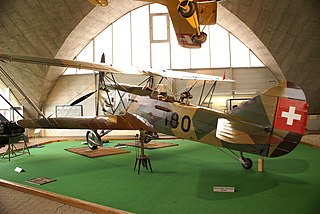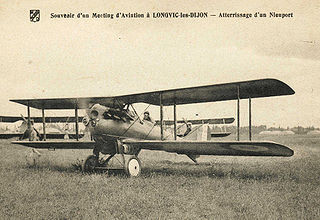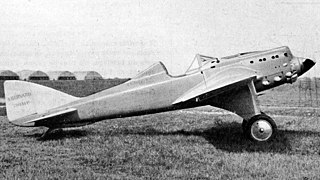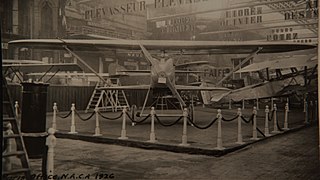
The Fiat CR.1 was an Italian biplane fighter aircraft of the 1920s. Of wood-and-fabric construction, it was designed by Celestino Rosatelli, from whom it gained the 'CR' designation. Its most distinctive feature was that the lower wings were longer than the upper ones.

The Fokker C.I was a German reconnaissance biplane under development at the end of World War I. The design was essentially an enlarged Fokker D.VII fighter with two seats and a 138 kW (185 hp) BMW IIIa engine. The C.I was originally developed to sell to the German Army. It never saw service in World War I, but Anthony Fokker managed to smuggle parts out of Germany at the time of the Armistice.

The Dewoitine D.338 was a 1930s French 22-passenger airliner built by Dewoitine.

The EKW C-35 was a 1930s Swiss two-seat reconnaissance biplane aircraft built by the Swiss Federal Construction Works, Thun.

The Nieuport-Delage NiD.29 was a French single-seat biplane fighter designed and built by Nieuport-Delage for the French Air Force.

The Potez 32 and its military version the Potez 33 was a single-engine French monoplane transport built by Potez and based on the Potez 29 biplane.

The Potez 39 was a French two-seat single-engined parasol wing monoplane reconnaissance and observation aircraft of the 1930s.

The Morane-Saulnier Vanneau is a two-seat basic trainer built in France by Morane-Saulnier and ordered by the French Air Force.

The Nieuport-Delage NiD 42 was a fighter aircraft built in France in the early 1920s, the first in a family of designs that would form the backbone of the French fighter force over the next decade.

The Dewoitine D.513 was a 1930s prototype French monoplane fighter designed and built by Dewoitine.

The Bernard SIMB AB 14 was a 1920s French single-seat sesquiplane fighter aircraft designed and built by the Société Industrielle des Métaux et du Bois (SIMB). With a reluctance of the French authorities to purchase monoplanes the Bernard 14 was designed as a sesquiplane with Y-form struts bracing the wings on each side. It was powered by a Hispano-Suiza 12Hb inline piston engine and had a fixed tailskid landing gear. While on a test flight on 22 February 1926 the aircraft suffered a catastrophic structural failure of the upper wing and the only Bernard 14 was destroyed.

The Bernard 20 was a 1920s French single-seat monoplane fighter aircraft designed and built by the Société des Avions Bernard. Originally displayed as a mock-up at the 1928 Paris Air Show it was a low-wing monoplane based on the Bernard V2 racer. The prototype powered by a 400 hp (298 kW) Hispano-Suiza 12Jb inline piston engine first flew in July 1929 from Orly. With its racing inheritance, in 1930 the aircraft flew at a speed of 280 km/h (174 mph). With the lack of interest by the French authorities for monoplanes the project was abandoned after 18 months of test flying.
The Bréguet 790 Nautilus was a prototype French three-seat coastal patrol flying-boat designed and built by Bréguet Aviation to meet a requirement from the French navy.

The Potez X was a French 1920s general-purpose colonial transport aircraft designed and built by Potez.

The Fokker T.IX was a Dutch twin-engined bomber designed and built by Fokker for the Royal Netherlands East Indies Army Air Force as a replacement for their obsolescent Martin-built bombers.

The Bernard 15 C1 or Bernard SIMB AB 15 was a 1920s French single-seat sesquiplane fighter aircraft designed and built by the Société Industrielle des Métaux et du Bois (SIMB). With the structural failure of the earlier Bernard 14 the Bernard 15 was an improved variant with a greater span upper wing. It was powered by a Hispano-Suiza 12Hb inline piston engine and had a fixed tailskid landing gear. The performance was not an improvement on the Bernard SIMB AB 14 and only the prototype was built.

The Hanriot H.35 was a 1920s French intermediate training monoplane designed and built by Avions Hanriot.

The Bernard 82 was a French single-engined long-range monoplane bomber designed and built by Société des Avions Bernard. Only two prototypes were built and the type did not enter production.
The Blériot 195 was a French monoplane mail-carrier designed and built by Blériot Aéronautique, the one aircraft built was modified a number of times but failed to enter production.

The CAMS 36 was a 1920s French flying boat designed and built by Chantiers Aéro-Maritimes de la Seine. It was originally conceived as a single-seat fighter but evolved as a racer to compete in the 1922 Schneider Trophy race. Lack of funds in 1922 and an accident in 1923 meant the two aircraft built failed to participate in a Schneider race.


















